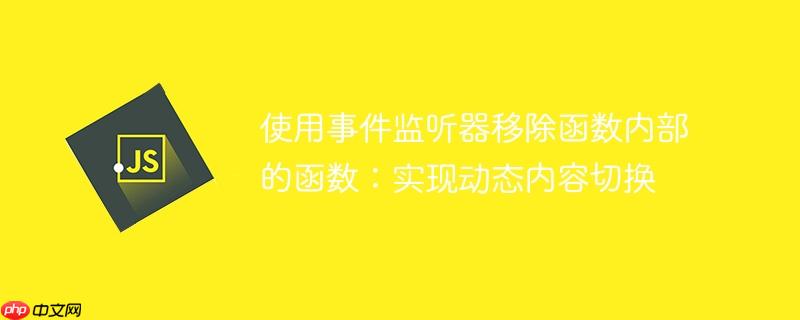
本文探讨了使用事件监听器实现动态内容切换的方案,重点介绍了如何通过条件渲染和清除页面的方式,根据用户的点击事件来动态地显示不同的内容模块。文章提供了一种高层次的解决方案,并强调了具体实现需要根据实际情况进行调整。
在Web开发中,动态内容切换是一个常见的需求,例如在单页应用(SPA)中,我们需要根据用户的点击在不同的页面内容之间进行切换,而无需重新加载整个页面。一个常见的场景是实现标签页切换(Tab Switching),当用户点击不同的标签时,页面上显示对应的内容。本文将介绍一种基于事件监听器和条件渲染的实现方法。
基本思路:条件渲染与页面清除
核心思路是将不同的内容模块(例如“首页”、“关于”、“联系方式”)分别封装成独立的函数,每个函数负责渲染该模块所需的HTML元素。然后,通过事件监听器监听用户的点击事件,根据用户点击的标签,决定调用哪个函数来渲染内容。
为了避免不同模块的内容互相干扰,每次切换内容之前,需要先清除页面上已有的内容。因此,我们需要一个clearPage函数,负责删除当前页面上的所有元素,为新的内容渲染做好准备。
实现步骤
定义内容渲染函数: 为每个内容模块(例如“首页”、“关于”、“联系方式”)创建一个独立的函数。每个函数负责创建并渲染该模块所需的HTML元素,并将其添加到页面的指定容器中。
function renderHome() {
// 创建首页的HTML元素
const homeElement = document.createElement('div');
homeElement.textContent = '这是首页内容';
// 将元素添加到页面容器
const container = document.getElementById('content-container');
container.appendChild(homeElement);
}
function renderAbout() {
// 创建关于页面的HTML元素
const aboutElement = document.createElement('div');
aboutElement.textContent = '这是关于页面内容';
// 将元素添加到页面容器
const container = document.getElementById('content-container');
container.appendChild(aboutElement);
}
function renderContact() {
// 创建联系方式页面的HTML元素
const contactElement = document.createElement('div');
contactElement.textContent = '这是联系方式页面内容';
// 将元素添加到页面容器
const container = document.getElementById('content-container');
container.appendChild(contactElement);
}创建页面清除函数: 创建一个clearPage函数,用于删除页面容器中的所有子元素。
function clearPage() {
const container = document.getElementById('content-container');
while (container.firstChild) {
container.removeChild(container.firstChild);
}
}添加事件监听器: 为每个标签页(例如“首页”、“关于”、“联系方式”)添加事件监听器,监听用户的点击事件。当用户点击某个标签页时,先调用clearPage函数清除页面内容,然后调用对应的渲染函数渲染新的内容。
const homeTab = document.getElementById('home-tab');
const aboutTab = document.getElementById('about-tab');
const contactTab = document.getElementById('contact-tab');
homeTab.addEventListener('click', () => {
clearPage();
renderHome();
});
aboutTab.addEventListener('click', () => {
clearPage();
renderAbout();
});
contactTab.addEventListener('click', () => {
clearPage();
renderContact();
});初始化页面: 在页面加载时,默认渲染“首页”内容。
window.onload = () => {
renderHome();
};示例代码(完整):
<!DOCTYPE html>
<html>
<head>
<title>动态内容切换</title>
</head>
<body>
<div id="header">
<button id="home-tab">首页</button>
<button id="about-tab">关于</button>
<button id="contact-tab">联系方式</button>
</div>
<div id="content-container">
<!-- 内容将在这里动态渲染 -->
</div>
<script>
function renderHome() {
const homeElement = document.createElement('div');
homeElement.textContent = '这是首页内容';
const container = document.getElementById('content-container');
container.appendChild(homeElement);
}
function renderAbout() {
const aboutElement = document.createElement('div');
aboutElement.textContent = '这是关于页面内容';
const container = document.getElementById('content-container');
container.appendChild(aboutElement);
}
function renderContact() {
const contactElement = document.createElement('div');
contactElement.textContent = '这是联系方式页面内容';
const container = document.getElementById('content-container');
container.appendChild(contactElement);
}
function clearPage() {
const container = document.getElementById('content-container');
while (container.firstChild) {
container.removeChild(container.firstChild);
}
}
const homeTab = document.getElementById('home-tab');
const aboutTab = document.getElementById('about-tab');
const contactTab = document.getElementById('contact-tab');
homeTab.addEventListener('click', () => {
clearPage();
renderHome();
});
aboutTab.addEventListener('click', () => {
clearPage();
renderAbout();
});
contactTab.addEventListener('click', () => {
clearPage();
renderContact();
});
window.onload = () => {
renderHome();
};
</script>
</body>
</html>注意事项与总结
总而言之,通过条件渲染和页面清除的方式,结合事件监听器,我们可以实现简单而有效的动态内容切换。 这种方法简单易懂,适用于小型项目或快速原型开发。 对于更复杂的应用,需要根据实际情况选择更合适的方案。
以上就是使用事件监听器移除函数内部的函数:实现动态内容切换的详细内容,更多请关注php中文网其它相关文章!

每个人都需要一台速度更快、更稳定的 PC。随着时间的推移,垃圾文件、旧注册表数据和不必要的后台进程会占用资源并降低性能。幸运的是,许多工具可以让 Windows 保持平稳运行。

Copyright 2014-2025 https://www.php.cn/ All Rights Reserved | php.cn | 湘ICP备2023035733号